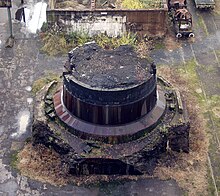Oven sow

Oven sow (also Salamander , Eisensau , Bodenensau , Bühnen , Härtlinge or Wolfe ) refers to the pig iron that accumulates on the floor below the tapping opening of a blast furnace during iron extraction , which cannot be tapped normally and which forms a solid block on the foundation when the blast furnace is shut down would. That is why it is drained through an additional tap opening that is drilled especially for this purpose, except for a small residue. The furnace sow can contain parts of rarer substances such as titanium or molybdenum .
If the additional stitch hole is set too high, a considerable part of the sow remains in the oven, which is then removed by blasting .
The term furnace sow is also used in non-ferrous metallurgy. However, the sometimes solid iron or very iron-rich phase that forms in the middle of the shaft furnace is referred to here as the furnace sow. This arises if the furnace temperature increases due to the increased reaction rate due to excessive use of the blast and the oxygen supplied in the blast with the excess coke enables a reduction in the iron oxide contained in the slag under normal conditions. If the temperature is high enough to keep the iron phase liquid, it can be removed with the slag. If the temperature is too low, due to the geometry of the shaft furnace and the arrangement as well as the blowing direction of the tuyeres, elongated iron phases can form along the vertical axis of symmetry. In non-ferrous metallurgy, these are known as furnace pigs.
If, for example, iron-rich lead ores are used in a lead shaft furnace, care must be taken to ensure that sufficient quantities of quartz as a slag-forming agent are added in order to reduce the risk of iron oxide reduction.
See also
Web links
- Iron sows . In: Heinrich August Pierer , Julius Löbe (Hrsg.): Universal Lexicon of the Present and the Past . 4th edition. tape 5 . Altenburg 1858, p. 588 ( zeno.org ).
- Entry of iron sows in Meyers Großes Konversations-Lexikon, Leipzig 1906. Volume 5, p. 564
literature
- Manuel Eissler: The metallurgy of argentiferous lead: a practical treatise on the smelting of silver-lead ores and the refining of lead bullion includion reports on various smelting Establishments in Europe and America. C. Lockwood and son, London 1891